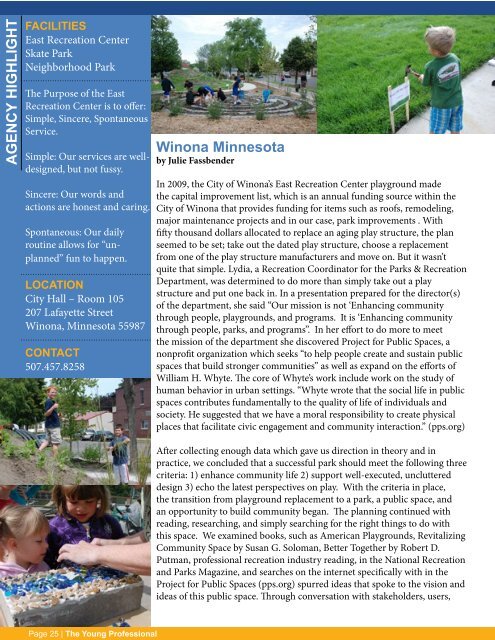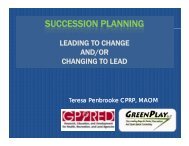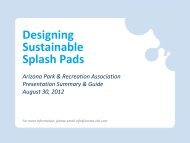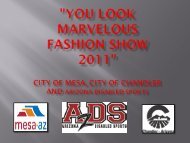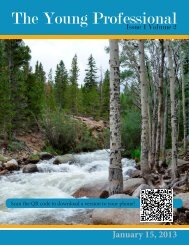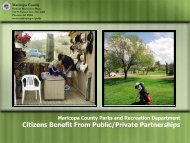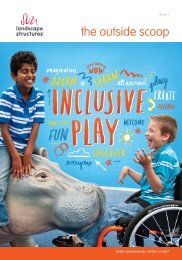The Young Professional 1 - Arizona Parks and Recreation Association
The Young Professional 1 - Arizona Parks and Recreation Association
The Young Professional 1 - Arizona Parks and Recreation Association
Create successful ePaper yourself
Turn your PDF publications into a flip-book with our unique Google optimized e-Paper software.
AGENCY HIGHLIGHTFACILITIESEast <strong>Recreation</strong> CenterSkate ParkNeighborhood Park<strong>The</strong> Purpose of the East<strong>Recreation</strong> Center is to offer:Simple, Sincere, SpontaneousService.Simple: Our services are welldesigned,but not fussy.Sincere: Our words <strong>and</strong>actions are honest <strong>and</strong> caring.Spontaneous: Our dailyroutine allows for “unplanned”fun to happen.LOCATIONCity Hall – Room 105207 Lafayette StreetWinona, Minnesota 55987CONTACT507.457.8258Winona Minnesotaby Julie FassbenderIn 2009, the City of Winona’s East <strong>Recreation</strong> Center playground madethe capital improvement list, which is an annual funding source within theCity of Winona that provides funding for items such as roofs, remodeling,major maintenance projects <strong>and</strong> in our case, park improvements . Withfifty thous<strong>and</strong> dollars allocated to replace an aging play structure, the planseemed to be set; take out the dated play structure, choose a replacementfrom one of the play structure manufacturers <strong>and</strong> move on. But it wasn’tquite that simple. Lydia, a <strong>Recreation</strong> Coordinator for the <strong>Parks</strong> & <strong>Recreation</strong>Department, was determined to do more than simply take out a playstructure <strong>and</strong> put one back in. In a presentation prepared for the director(s)of the department, she said “Our mission is not ‘Enhancing communitythrough people, playgrounds, <strong>and</strong> programs. It is ‘Enhancing communitythrough people, parks, <strong>and</strong> programs”. In her effort to do more to meetthe mission of the department she discovered Project for Public Spaces, anonprofit organization which seeks “to help people create <strong>and</strong> sustain publicspaces that build stronger communities” as well as exp<strong>and</strong> on the efforts ofWilliam H. Whyte. <strong>The</strong> core of Whyte’s work include work on the study ofhuman behavior in urban settings. “Whyte wrote that the social life in publicspaces contributes fundamentally to the quality of life of individuals <strong>and</strong>society. He suggested that we have a moral responsibility to create physicalplaces that facilitate civic engagement <strong>and</strong> community interaction.” (pps.org)After collecting enough data which gave us direction in theory <strong>and</strong> inpractice, we concluded that a successful park should meet the following threecriteria: 1) enhance community life 2) support well-executed, uncluttereddesign 3) echo the latest perspectives on play. With the criteria in place,the transition from playground replacement to a park, a public space, <strong>and</strong>an opportunity to build community began. <strong>The</strong> planning continued withreading, researching, <strong>and</strong> simply searching for the right things to do withthis space. We examined books, such as American Playgrounds, RevitalizingCommunity Space by Susan G. Soloman, Better Together by Robert D.Putman, professional recreation industry reading, in the National <strong>Recreation</strong><strong>and</strong> <strong>Parks</strong> Magazine, <strong>and</strong> searches on the internet specifically with in theProject for Public Spaces (pps.org) spurred ideas that spoke to the vision <strong>and</strong>ideas of this public space. Through conversation with stakeholders, users,Page 25 | <strong>The</strong> <strong>Young</strong> <strong>Professional</strong>


